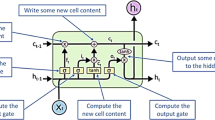Abstract
The railway transportation industry is one of the essential factors to promote economic development, so research is made on improving the investment benefit of construction planning of the railway transportation industry, and on this basis, the national emergency attribute is analyzed. A prediction model of railway transportation investment benefits and national economic attributes based on EEMD-LSTM (ensemble empirical mode decomposition—long-short-term memory) model is proposed. The EEMD algorithm is used to decompose the daily investment price of the railway transportation industry to obtain the IMF (intrinsic mode function) with different cycle characteristics. The daily investment price, IMF component, and residual series of the railway transportation industry are taken as input data. The input data are transmitted through the LSTM model to predict the investment price of the next day. The results show that the EEMD-LSTM model can retain the advantages of EEMD and LSTM and meet the accurate prediction of financial data. The model has good performance for the fitting of actual data and forecast data, and the model has the highest prediction accuracy of 0.2964%. In conclusion, the model proposed is a useful model for predicting financial time series. The exploration can provide an absolute theoretical basis for the formulation and planning of investment risk coping strategies of the railway transportation industry and provide particular theoretical support for the national economic attribute and positioning of the railway transportation industry.








Similar content being viewed by others
References
Ananth C, Nagarajan K, Kumar V (2017) A smart approach for secure control of railway transportation systems. Soc Sci Electron Publ 117(15):1215–1221
Gao Y, Yang L, Li S (2016) Uncertain models on railway transportation planning problem. Appl Math Model 40(7–8):4921–4934
Azadeh A, Salehi V, Kianpour M (2018) Performance evaluation of rail transportation systems by considering resilience engineering factors: Tehran railway electrification system. Transp Lett 10(1):12–25
Yin J, Tang T, Yang L et al (2017) Research and development of automatic train operation for railway transportation systems: a survey. Transp Res Part C: Emerging Technol 85:548–572
Lin DY, Fang JH, Huang KL (2019) Passenger assignment and pricing strategy for a passenger railway transportation system. Transp Lett 11(6):320–331
Ghofrani F, He Q, Goverde RMP et al (2018) Recent applications of big data analytics in railway transportation systems: a survey. Transp Res Part C: Emerging Technol 90:226–246
Vickerman R (2018) Can high-speed rail have a transformative effect on the economy? Transp Policy 62:31–37
Ke X, Chen H, Hong Y et al (2017) Do China’s high-speed-rail projects promote local economy?—new evidence from a panel data approach. China Econ Rev 44:203–226
Wu S, Chong A (2018) Developmental railpolitics: the political economy of China’s high-speed rail projects in Thailand and Indonesia. Contemp Southeast Asia 40(3):503–526
Li X, Fan Y, Wu L (2017) CO2 emissions and expansion of railway, road, airline and in-land waterway networks over the 1985–2013 period in China: a time series analysis. Transp Res Part D Transp Environ 57:130–140
Andersson H, Hultkrantz L, Lindberg G et al (2018) Economic analysis and Investment priorities in Sweden’s transport sector. J Benefit-Cost Anal 9(1):120–146
Fischer T, Krauss C (2018) Deep learning with long short-term memory networks for financial market predictions. Eur J Oper Res 270(2):654–669
Yan H, Ouyang H (2018) Financial time series prediction based on deep learning. Wireless Pers Commun 102(2):683–700
Moews B, Herrmann JM, Ibikunle G (2019) Lagged correlation-based deep learning for directional trend change prediction in financial time series. Expert Syst Appl 120:197–206
Wei LY (2016) A hybrid ANFIS model based on empirical mode decomposition for stock time series forecasting. Appl Soft Comput 42:368–376
Wang J, Wang J (2017) Forecasting stochastic neural network based on financial empirical mode decomposition. Neural Netw 90:8–20
Lahmiri S (2016) A variational mode decompoisition approach for analysis and forecasting of economic and financial time series. Expert Syst Appl 55:268–273
Nava N, Di Matteo T, Aste T (2018) Dynamic correlations at different time-scales with empirical mode decomposition. Physica A 502:534–544
Yaslan Y, Bican B (2017) Empirical mode decomposition based denoising method with support vector regression for time series prediction: a case study for electricity load forecasting. Measurement 103:52–61
Zhang N, Lin A, Shang P (2017) Multidimensional k-nearest neighbor model based on EEMD for financial time series forecasting. Physica A 477:161–173
Chong Z, Qin C, Chen Z et al (2019) Estimating the economic benefits of high-speed rail in China: a new perspective from the connectivity improvement. J Transp and Land Use 12(1):287–302
Acknowledgements
This work was supported in part by the Research on the major theoretical and practical problems of Social Sciences in Shaanxi Province. Project No.: 2019Z003
Author information
Authors and Affiliations
Corresponding author
Additional information
Publisher's Note
Springer Nature remains neutral with regard to jurisdictional claims in published maps and institutional affiliations.
Rights and permissions
About this article
Cite this article
He, J. Application of deep learning model under improved emd in railway transportation investment benefits and national economic attribute analysis. J Supercomput 77, 8194–8208 (2021). https://doi.org/10.1007/s11227-020-03609-z
Accepted:
Published:
Issue Date:
DOI: https://doi.org/10.1007/s11227-020-03609-z




